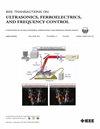Numerical Simulation of Intravascular Ultrasound Images Based on Patient-Specific Computed Tomography
IF 3
2区 工程技术
Q1 ACOUSTICS
IEEE transactions on ultrasonics, ferroelectrics, and frequency control
Pub Date : 2024-12-25
DOI:10.1109/TUFFC.2024.3523037
引用次数: 0
Abstract
Intravascular ultrasound (IVUS) provides detailed imaging of the artery circumference. Over the past years, the interest in artificial intelligence (AI) for interpretation and automatic analysis of IVUS images has grown. Development of such algorithms typically requires considerable amounts of annotated data. However, manual annotation of IVUS data is time-consuming and expensive. An alternative solution would be the simulation of IVUS data, which yields images with all necessary ground-truth data available. Therefore, in this study, we present an IVUS simulator to simulate realistic IVUS data based on computed tomography (CT) images. The IVUS transducer is modeled accurately, which is reflected in the in vitro and in silico measurements of the point-spread function (PSF) and speckle size. The capability of simulating realistic IVUS images is showcased on an in vivo co-registered CT-IVUS dataset of two patients with an abdominal aortic aneurysm (AAA). Quantitative results, expressed in terms of the Jensen-Shannon divergence (JSD), speckle signal-to-noise ratio (sSNR), and contrast-to-noise ratio (CNR), reveal the high similarity between the in vivo and in silico IVUS images. The proposed simulator is promising for ultrasound data generation, enabling the generation of IVUS images with the desired ground truth.基于患者特异性计算机断层扫描的血管内超声图像数值模拟
血管内超声(IVUS)提供动脉周长的详细成像。在过去的几年中,对人工智能(AI)用于IVUS图像的解释和自动分析的兴趣有所增长。这种算法的开发通常需要大量的注释数据。然而,手工标注IVUS数据既耗时又昂贵。另一种解决方案是模拟IVUS数据,生成具有所有必要的真实数据的图像。因此,在本研究中,我们提出了一个IVUS模拟器来模拟基于计算机断层扫描(CT)图像的真实IVUS数据。IVUS换能器精确建模,这反映在体外和计算机测量的点扩散函数(PSF)和散斑大小。模拟真实IVUS图像的能力在两名腹主动脉瘤(AAA)患者的体内联合注册CT-IVUS数据集上得到了展示。以Jensen-Shannon散度(JSD)、散斑信噪比(sSNR)和噪声对比比(CNR)表示的定量结果显示,活体和计算机IVUS图像高度相似。所提出的模拟器有望用于超声数据生成,使IVUS图像的生成具有所需的地面真实度。
本文章由计算机程序翻译,如有差异,请以英文原文为准。
求助全文
约1分钟内获得全文
求助全文
来源期刊
CiteScore
7.70
自引率
16.70%
发文量
583
审稿时长
4.5 months
期刊介绍:
IEEE Transactions on Ultrasonics, Ferroelectrics and Frequency Control includes the theory, technology, materials, and applications relating to: (1) the generation, transmission, and detection of ultrasonic waves and related phenomena; (2) medical ultrasound, including hyperthermia, bioeffects, tissue characterization and imaging; (3) ferroelectric, piezoelectric, and piezomagnetic materials, including crystals, polycrystalline solids, films, polymers, and composites; (4) frequency control, timing and time distribution, including crystal oscillators and other means of classical frequency control, and atomic, molecular and laser frequency control standards. Areas of interest range from fundamental studies to the design and/or applications of devices and systems.

 求助内容:
求助内容: 应助结果提醒方式:
应助结果提醒方式:


